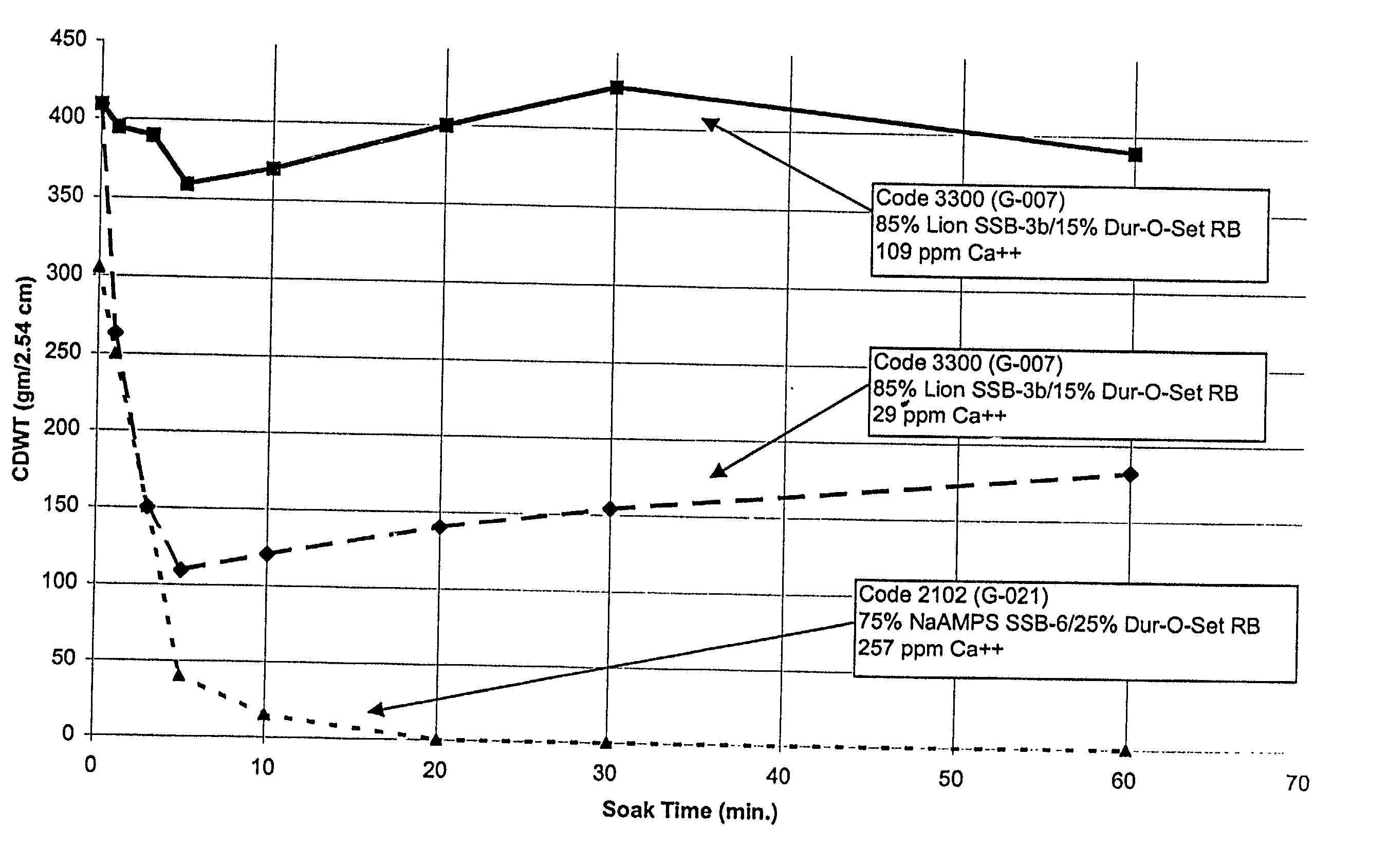Ion-sensitive, water-dispersible polymers, a method of making same and items using same
a water-dispersible polymer and ion-sensitive technology, applied in the field of ion-sensitive water-dispersible polymers, a method of making same and items using same, can solve the problems of inability to create an economical coherent fibrous web, the inability of products to disintegrate in landfills, and the inability to create a coherent fibrous web. economical and practical advantages
- Summary
- Abstract
- Description
- Claims
- Application Information
AI Technical Summary
Problems solved by technology
Method used
Image
Examples
example 1
Preparation of Sulfonate Anion Modified Acrylic Acid Terpolymer
[0198] Acrylic acid (43.3 g, 0.60 mol), AMPS (10.7 g, 0.052 mol), butyl acrylate (35.2 g, 0.27 mol), and 2-ethylhexyl acrylate (20 g, 0.11 mol) were dissolved in 55 g of acetone / water (70 / 30) mixture. An initiator, 2,2-azobisisobutyronitrile (AIBN) (0.51 g, 3..times.10.sup.-3 mol), was dissolved in 20 ml of acetone. The monomer solution was deoxygenated by bubbling N.sub.2 through the solution for 20 minutes. To a 1000 ml three-neck round bottom flask, equipped with a condenser, two addition funnels and a magnetic stirrer, was added 120 g of an acetone / water (70 / 30) mixture. The solvent was heated to gentle reflux under nitrogen. Monomers and initiator were added simultanously from the addition funnels over a period of two hours. Polymerization was allowed to proceed for an additional two hours, at the end of which, the addition funnels and condenser were replaced with a distillation head and a mechanical stir rod to rem...
example 2
Preparation of an Acrylic Acid Terpolymer
[0200] An acrylic acid terpolymer was produced using the polymerization procedure outlined in Example 2 of U.S. Pat. No. 5,312,883. The following monomers were used: acrylic acid (50 g, 0.69 mol), butyl acrylate (25 g, 0.20 mol), and 2-ethylhexyl acrylate (25 g, 0.14 mol). The polymer was neutralized with 0.1 mole sodium hydroxide.
example 3
Preparation of Ion-sensitive Polymer Formulation
[0201] The polymers prepared in Table 5, Sample 9 and Example 2 above were combined with Dur-O-Set RB to form the ion-sensitive polymer formulations of the present invention. The polymer formulations were prepared as shown in Table 6 below.
6TABLE 6 Ion-Sensitive Polymer Formulations % Terpolymer % Modified Terpolymer Sample (Example 2) (Table 5, Sample 9) % EVA 1 85.0 0.0 15.0 2 0.0 85.0 15.0 3 65.0 0.0 35.0 4 0.0 65.0 35.0 5 95.0 0.0 5.0 6 0.0 95.0 5.0 7 55.0 0.0 45.0 8 0.0 55.0 45.0 9 75.0 0.0 25.0 10 0.0 75.0 25.0
PUM
| Property | Measurement | Unit |
|---|---|---|
| weight percent | aaaaa | aaaaa |
| weight percent | aaaaa | aaaaa |
| weight percent | aaaaa | aaaaa |
Abstract
Description
Claims
Application Information
 Login to View More
Login to View More - R&D
- Intellectual Property
- Life Sciences
- Materials
- Tech Scout
- Unparalleled Data Quality
- Higher Quality Content
- 60% Fewer Hallucinations
Browse by: Latest US Patents, China's latest patents, Technical Efficacy Thesaurus, Application Domain, Technology Topic, Popular Technical Reports.
© 2025 PatSnap. All rights reserved.Legal|Privacy policy|Modern Slavery Act Transparency Statement|Sitemap|About US| Contact US: help@patsnap.com



